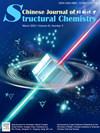From [Ba3S][GeS4] to [Ba3CO3][MS4] (M = Ge, Sn): Enhancing optical anisotropy in IR birefringent crystals via functional group implantation
IF 5.9
4区 化学
Q1 CHEMISTRY, INORGANIC & NUCLEAR
引用次数: 0
Abstract
Birefringent crystals are crucial for manipulating light's phase and polarization, making them vital components in various optical devices. Traditionally, strategies for designing high-performance birefringent crystals have focused on modifying the parent structure. However, there are limited examples demonstrating how changing functional groups can effectively enhance birefringence (Δn), as such changes often significantly alter the crystal structure. In this study, we propose a “functional group implantation” strategy aiming at significantly improving birefringent performance within the chalcogenide system. This involves replacing the isotropic [S]2– ions with anisotropic π-conjugated [CO3]2– groups. We validated this approach through comprehensive comparisons between the chalcogenide [Ba3S][GeS4] and oxychalcogenide [Ba3CO3][MS4] (M = Ge and Sn), both of which adopt the same space group and feature the same arrangements of functional groups. Experimental characterization and theoretical calculations confirm that the [CO3]2– groups exhibit significantly greater polarization anisotropy than the [S]2– groups. This difference leads to a marked increase in Δn in [Ba3CO3][MS4] (ranging from 0.088 to 0.112 at 546 nm) compared to [Ba3S][GeS4] (0.021 at 546 nm). This finding not only broadens the structural chemistry of π-conjugated chalcogenides but also illustrates the potential of functional group implantation for designing infrared birefringent crystals with enhanced optical anisotropy.

求助全文
约1分钟内获得全文
求助全文
来源期刊

结构化学
化学-晶体学
CiteScore
4.70
自引率
22.70%
发文量
5334
审稿时长
13 days
期刊介绍:
Chinese Journal of Structural Chemistry “JIEGOU HUAXUE ”, an academic journal consisting of reviews, articles, communications and notes, provides a forum for the reporting and discussion of current novel research achievements in the fields of structural chemistry, crystallography, spectroscopy, quantum chemistry, pharmaceutical chemistry, biochemistry, material science, etc. Structural Chemistry has been indexed by SCI, CA, and some other prestigious publications.
 求助内容:
求助内容: 应助结果提醒方式:
应助结果提醒方式:


